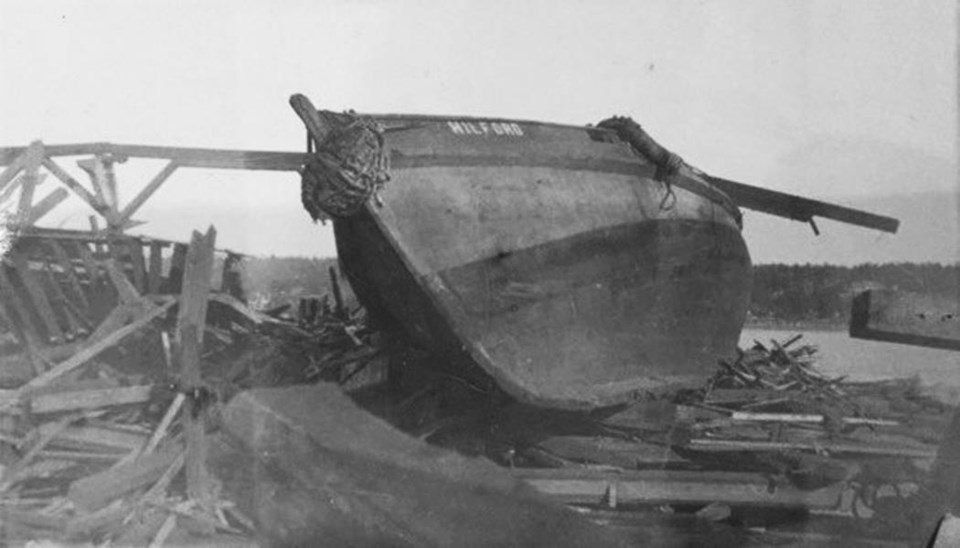A 1917 Halifax Explosion Profile: Captain James Anderson Murray, Convoy Officer
Posted Dec 6, 2022 05:44:00 PM.
James Anderson Murray (Lt., R.N.V.R., R.N.C.V.R) was born at Manchester, UK, and as a youth, attended the Hulme Grammar School. He was a Younger Brother of Trinity House, Fellow of the Royal Geographic Society and Merchant Marine captain of the passenger liners RMS Empress of Britain and the ill-fated RMS Empress of Ireland. Both ships has been built at Fairfield Shipbuilding and Engineering in Scotland for the Canadian Pacific Steamship fleet.
Murray went to sea in 1879 which was rather late for a young man those days. He received his Captains certificate # 09829 in 1887 and served on many Elder Dempster Lines vessels. He was a member of the Royal Naval Reserve and a Fellow of the Royal Geographic Society. He was a meticulous captain and record-keeper and paid attention to the smallest of details. Captain Murray plied the West African coast, Indian Ocean, South America and the West Indies. He became master of the vessel Lake Manitoba in 1904 and Empress of Britain in Aug. 1906.
Just prior to the April 1912 sinking of RMS Titanic in the North Atlantic, a Marconigram communication took place between Captains Murray and Smith:
Marconigram to Titanic from Empress of Britain, 12 Apr. 1912:
Commr. Titanic. Officers and self send greetings and best of luck to the Titanic her Officers and Commander. Murray.Marconigram to Commander Empress of Britain, 12 April, 1912:
Many thanks for your kind message from all here. Smith.
In February 1914, Murray took over command of Empress of Ireland for a short tenure and handed command of the ship over to Captain Kendall in May. Subsequently, Captain Murray served as Harbor Master at Quebec at a salary of $4,000 per year. Murray later became assistant to Rear Admiral Bertram M. Chambers at Landsdowne, Cape Breton. When the admiral was assigned to take charge of the British Convoy Office in Halifax, Lt. Murray accompanied him.
Chambers was the most senior officer of the Royal Navy in the city. In December 1917, he and Murray were only a handful of personnel aware of the T.N.T. cargo carried aboard SS Mont-Blanc. However, it cannot be stated with absolute certainty that those at the Convoy Office knew the full extent of the presence or high volatility of the tons of picric acid other explosives aboard. Captain Murray was borne to HMCS Niobe as an instructor and became the port's convoy officer. He was extremely popular with the officers and men of the ships which entered the harbour to join convoys readying for the transatlantic crossing to Europe.
On the morning of the explosion, Captain Murray had already returned from his duties in Bedford Basin and was patrolling the harbour when the collision occurred between Mont-Blanc and SS Imo. Purportedly, he sent a sailor ashore to warn others of a possible explosion, notably, Vince Coleman at the railway depot near Pier 6. Murray himself had an office at Pier 9 and was killed instantly. His tug, Hilford was carried by the tsunami wave to rest atop a pile of lumber approximately 30 feet above the water line.

It was Admiral Chambers who discovered Murray's body during a tour up the harbour in the late morning following the blast. From an “anonymous” account in the Naval Review, 1920:
“Amidst the ruins wandered a few dazed creatures, blood-stained and in rags. They were the remains of the military guard stationed at the pier. Many of the guard were in a dying condition, others had been pinned to the ground by the flying masses of timber. Beneath one of the piles I could distinguish the body of my very capable second assistant, Lieut.-Commander T.[sic] A. Murray, R.N.C.V.R., who had been making a telephonic report to the convoy office at the time the explosion took place.”
Murray's body could not be recovered until the following day. In the meantime, a new complication, a fierce blizzard, made the recovery effort extremely difficult.
“As the day wore on, the weather became worse and worse, the snow being absolutely blinding and forming deep drifts. My own staff had been since daylight rescuing the body of their comrade, Lieut.-Commander J. A. Murray. which they did under very trying conditions.”
James A. Murray was posthumously promoted to the rank of Lt. Commander. His remains were interred at Mount Hermon Cemetery in Quebec City. The image showing CPR Captain Murray, on the bridge of one of the Empresses, was provided for my book, Scapegoat, by his great grandson, Greg Murray, also a member of the RCN.
Captain Arthur W. Hickey and deckhand Charles Perham of the tug Hilford also died in the explosion.
(Please note: A Canadian Pacific ship's captain traditionally wore three stripes as opposed to the Royal Navy’s four stripes.)








